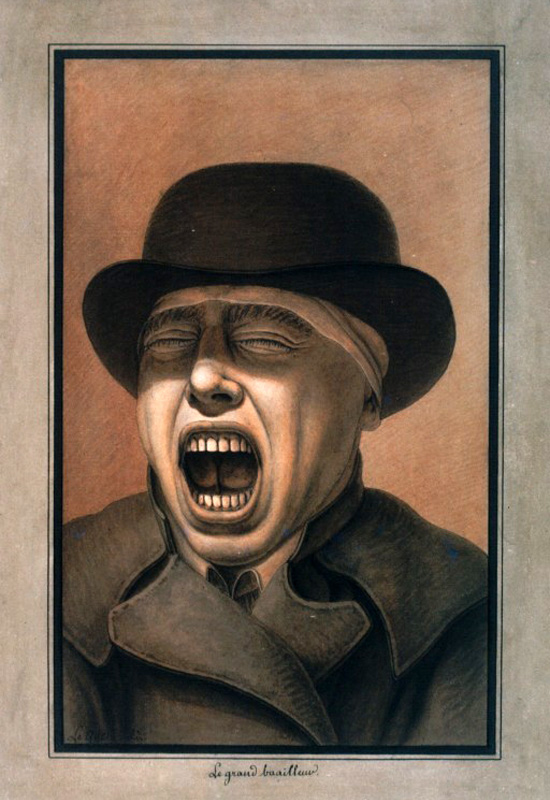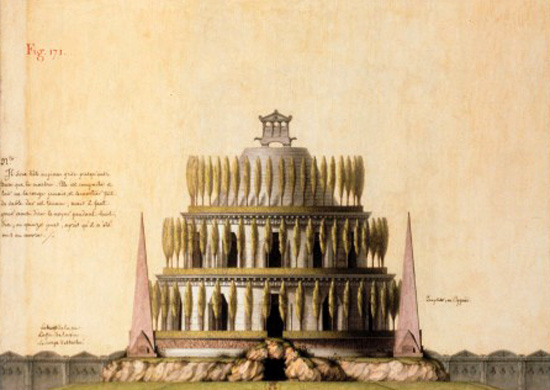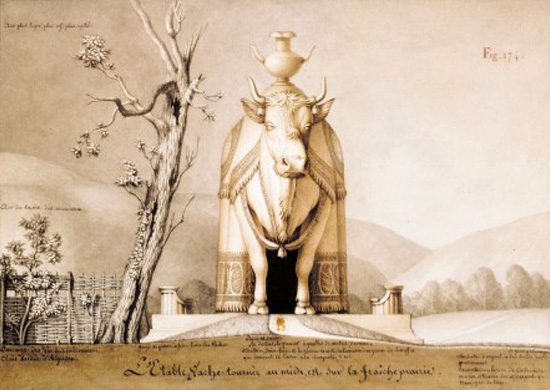
Why no cinematic biography of Jean-Jacques Lequeu has been produced yet is a mystery to me. All the elements of an Oscar-winning drama are there. You have a genius protagonist, a visionary, who toils not in the hallowed halls of the Academy but in decrepit offices, out there in the margins of the art world. By day, he is surround by bureaucrats and the machinations of the state, but by day's end, he walks home to a brothel.
In post-Revolution and Napoleon France, Lequeu produced some of the most imaginative landscape and architectural designs, some a masterful combination of the Gothic, the Egyptian, the Greek, the Chinese, and a smattering of hallucinations. However, except for two folies in Rouen, none were ever constructed. He was somewhat of a pornographer as well and at least in his self-portraits, a cross-dresser. As there are too few sources to go by, the screenwriter can easily color his life some more. After all, he did create portraits of nuns bearing their breasts.

For some tension, a rivalry between Lequeu and another architect with similar visionary yet unbuilt works, Étienne-Louis Boullée, can be dramatized. By Lequeu (supposedly):
You Artists who demand Justice, Awake! A clique has been formed in the Jury of the Arts set up by the National Convention […] A kind of architectural lunatic, the seventy-year-old Boullée is at the centre of it and has arranged everything to his advantage […] and keep an eye on that humbug Ledoux and the smug charlatan Le Roy.
So in a sort of pseudo-sequel to Peter Shaffer's Amadeus, Lequeu becomes Salieri, seething with envy and animosity at the more celebrated Mozart, i.e., Boullée. But inversely, the bureaucratic draughtsman is truly the more sublime artist, the one favored by God with the gift to fill Man's soul with Divine Grace, though unfortunately, he still dies penniless and in obscurity. As a parallel to the burial scene at a potter's field in Milos Forman's cinematic version of Shaffer's play, an epilogue will show a family member or maybe a co-worker braving the rain and the thrash-strewn streets towards the Bibliothèque nationale de France to which Lequeu's entire oeuvre will be anonymous donated. Or perhaps it will be one of Lequeu's favorite nudist nuns to ensure that posterity will be able to rediscover his genius? As always, it's the profane that sustains the sacred.

I was first introduced to Lequeu when a professor recommended Phillippe Duboy's manuscript on the artist, subtitled An Architectural Enigma for a studio project on boundaries. I was then investigating ritualistic boundaries and the forms and processes in which a unified space becomes delineated in varying levels of sacrality. Seeing Lequeu's sections of interior spaces, I knew it was smooth sailing from then on. But of course, there followed images and images of protruding penises, cavernous vaginas, hairy legs and chests, and more penises and vaginas. What little image I had of landscape architecture as a gentlemanly, quiet profession was erased for good, and it didn't matter whether Lequeu was considered a landscape or a garden designer or not. The deed was done. No holes barred from then on.

I relate this anecdote for two things: 1) In my imaginary movie, this would serve as a prologue: the scene opens on the wind-swept prairie of the Midwest, an all-too eager student... fade to black, then a shot of Lequeu in a brothel... perhaps the student is the Bastian to Lequeu's Atreyu... perhaps not; and 2) Lequeu's designs seem to have been influenced by the ancient practice of augury - ritualistic, mystical, and highly differentiated. So in the novelization phase of my imaginary movie, Dan Brown will concoct a historical fantamagical story of a super secret religious society guarding a terrifying truth at all cost. The Lequeu Code. Spielberg-Merchant-Ivory will produce the schmaltziest movie ever as only they could. Oscars for Art Direction and Costumes are a lock, and Lequeu's name will forever be ingrained in popular culture.


Anyway, one can peruse the entire collection online at the BNF's Gallica website, which originally was the whole point of this entry.
And for another figure who deserves a cinematic treatment, go here.
Jean-Jacques Lequeu @ Gallica